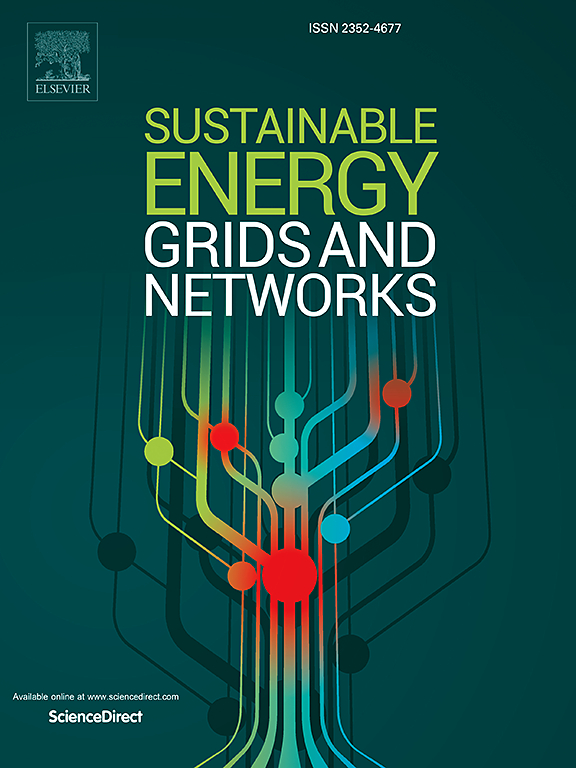Joint optimization of fleet sizing, charging station planning, and operation for autonomous electric vehicle fleets in urban transportation networks
IF 5.6
2区 工程技术
Q2 ENERGY & FUELS
引用次数: 0
Abstract
The rapid advancement of autonomous electric vehicles (AEVs) is reshaping urban transportation, presenting new opportunities for ride-hailing fleets. Under a vertically integrated structure and a unified economic objective, this study develops a mixed-integer linear programming model that jointly optimizes vehicle loading/rebalancing, order acceptance/abandonment, and charging/discharging operations, while accounting for AEV and charging station investments, charging and maintenance costs, and discharging and passenger revenues to maximize the operator’s net present value. One year of New York City Yellow Taxi trip data is processed by sampling from empirical distributions and introducing distributional noise using maximum likelihood estimation and the Akaike Information Criterion to capture travel demand characteristics and uncertainties. The model is tested across six operational modes within a 24-node transportation network that aggregates New York City’s taxi pick-up and drop-off zones and integrates real-world travel distances, speeds, and electricity prices. Results show that rebalancing reduces investment costs by approximately 50 %, while a flexible order acceptance strategy strategically abandons extreme congestion orders during peak hours, resulting in a 3.5 % cost reduction. Discharging operations improve charging pile utilization by 7 %. Sensitivity analysis reveals that higher driving speed and vehicle-to-grid incentives enhance profitability, a charging power of charging piles with 80 kW achieves a favorable cost–benefit trade-off, while the marginal benefits of increasing AEV battery capacity and charging/discharging power gradually decline as operational benefits approach saturation. These findings offer a practical framework for operators and planners to deploy cost-effective AEV fleets in urban transportation networks.
城市交通网络中自主电动汽车车队规模、充电站规划与运行的联合优化
自动驾驶电动汽车(aev)的快速发展正在重塑城市交通,为网约车车队带来了新的机遇。在垂直整合的结构和统一的经济目标下,本研究建立了混合整数线性规划模型,在考虑电动汽车和充电站投资、充电和维护成本、放电和乘客收入的同时,共同优化车辆装载/再平衡、订单接受/放弃和充电/放电操作,以最大化运营商的净现值。本文利用最大似然估计和赤池信息准则对纽约市黄色出租车一年的出行数据进行抽样处理,并引入分布噪声来捕捉出行需求特征和不确定性。该模型在一个24节点的交通网络中进行了六种运营模式的测试,该网络汇集了纽约市的出租车上下车区,并整合了现实世界的行驶距离、速度和电价。结果表明,再平衡使投资成本降低了约50% %,而灵活的订单接受策略策略性地放弃了高峰时段的极端拥堵订单,导致成本降低了3.5 %。放电操作使充电桩利用率提高了7 %。灵敏度分析表明,较高的行驶速度和车辆入网激励提高了盈利能力,充电桩充电功率为80 kW时达到了较好的成本效益权衡,而随着运营效益接近饱和,增加电动汽车电池容量和充放电功率的边际效益逐渐下降。这些发现为运营商和规划者在城市交通网络中部署具有成本效益的自动动力汽车车队提供了一个实用框架。
本文章由计算机程序翻译,如有差异,请以英文原文为准。
求助全文
约1分钟内获得全文
求助全文
来源期刊

Sustainable Energy Grids & Networks
Energy-Energy Engineering and Power Technology
CiteScore
7.90
自引率
13.00%
发文量
206
审稿时长
49 days
期刊介绍:
Sustainable Energy, Grids and Networks (SEGAN)is an international peer-reviewed publication for theoretical and applied research dealing with energy, information grids and power networks, including smart grids from super to micro grid scales. SEGAN welcomes papers describing fundamental advances in mathematical, statistical or computational methods with application to power and energy systems, as well as papers on applications, computation and modeling in the areas of electrical and energy systems with coupled information and communication technologies.
 求助内容:
求助内容: 应助结果提醒方式:
应助结果提醒方式:


